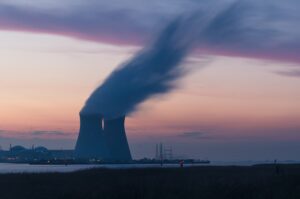 Once again, the Atlantic hurricane season has demonstrated the impacts of climate change. Hurricane Ian made landfall in Florida as a category 4 storm in late September. It rapidly intensified to a “500-year flood event,” per Florida Governor Ron DeSantis, leveling communities, leaving millions without power, killing an untold number of people, and likely leaving behind billions of dollars in property damage. This follows a year of droughts, wildfires, and unrelenting heat. Clearly, the climate crisis is here.
Once again, the Atlantic hurricane season has demonstrated the impacts of climate change. Hurricane Ian made landfall in Florida as a category 4 storm in late September. It rapidly intensified to a “500-year flood event,” per Florida Governor Ron DeSantis, leveling communities, leaving millions without power, killing an untold number of people, and likely leaving behind billions of dollars in property damage. This follows a year of droughts, wildfires, and unrelenting heat. Clearly, the climate crisis is here.
But we have answers to that crisis if we are willing to use them.
Governments at all levels are already working towards becoming “net zero,” a goal to eliminate carbon emissions and incentivize the development and use of clean energy. One key solution to this energy transition is the use of hydrogen, in particular as a way to decarbonize hard-to-abate sectors such as aviation, marine shipping, steel and cement production, and industrial heating. But hydrogen is difficult to obtain at a large scale using only renewable energy sources like wind and solar. Nonetheless, there is a perception that only renewables can be used to produce hydrogen in a perfect net-zero economy.
This drive for perfection is the enemy of the good. The International Energy Agency (IEA) estimates that 530 Mt of low-carbon hydrogen will be needed by 2050 to support a net-zero economy, but a key challenge is ensuring “sufficient electricity generation capacity.” Every zero-carbon method of producing electricity will be needed to generate enough carbon-free hydrogen to reach the necessary levels, including nuclear energy.
Nuclear energy is large-scale, high capacity, high heat, and zero carbon – all of the criteria needed to support large-scale hydrogen production in a net-zero economy. For example, nuclear power plants’ average capacity factors are above 92% (that is, they produce power greater than 92% of the time). This is higher than the capacity factors of any other type of power plant and it makes nuclear energy uniquely reliable for industrial uses like generating hydrogen. Nuclear power plants also operate at very high temperatures, increasing the efficiency of hydrogen generation through electrolysis. Advanced reactors could further improve the efficiency of electrolysis while providing flexibility in siting and distribution.
Hydrogen produced using nuclear energy, also known as nuclear hydrogen, could make net zero goals a reality, and it deserves our support. That is why we created the Nuclear Hydrogen Initiative (NHI): a coalition of private and public stakeholders advancing policy solutions, addressing technical barriers, catalyzing commercial partnerships, and engaging the financial community to support the contribution of nuclear energy in scaling clean hydrogen production. To achieve net zero we need every solution, not just perfect solutions.
We are pleased that governments are recognizing this need, although more can be done. For example, the United States Department of Energy (DOE) is seeking applications for projects in “Nuclear Coupled Hydrogen Production and Use” in an effort to support the development of nuclear plant thermal integration required for high-temperature hydrogen production or hydrogen-coupled end uses for nuclear energy. The DOE has also recently announced billions of dollars in funding for clean hydrogen hubs, at least one of which will be based on nuclear energy. In addition to developments in the United States, the United Kingdom is seeking to generate 10 GW of hydrogen by 2030 and has included nuclear in its national hydrogen strategy. The Dutch government has announced plans to build two new nuclear reactors for hydrogen production. Other countries are also pursuing hydrogen production using nuclear power.
There is much to be done to achieve net zero and eliminate carbon from our economy; however, recognizing nuclear energy as a valid and necessary means to produce hydrogen is a start.